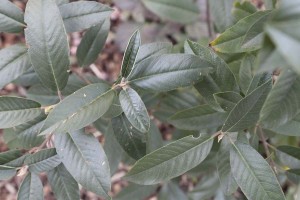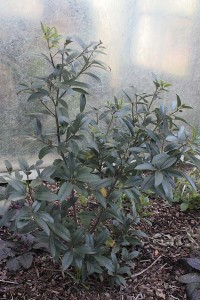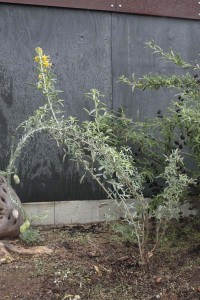Fill in the blank:
California coffeeberries are __________
- versatile in the landscape
- important members of the ecosystem
- boring as dirt
Coffeeberries, Frangula californica (aka Rhamnus californica) are common plants in California native plant gardens. The plants stay green and leafy all year and provide a welcome evergreen background for other species that go through more extravagant bloom-and-bust cycles. They’re tough plants, and you can find clones that tolerate higher water parts of the garden as well as areas that subsist on natural rainfall.
The species produces berries that progress from red to purple to black over the course of the summer. Any plant that produces berries is likely to be an important food source for wildlife. Earlier in the season, in flower, it keeps pollinators happy.

But until recently, I’d viewed them as fairly uninteresting plants, and I’d have answered “3” to the fill-in-the-blank above. I had none in the garden.
That changed a couple years ago with the introduction to the garden of several plants of two different clones. In the wilds the typical form can get pretty large–fifteen feet tall in the shade, and more, and even wider. But garden selections let you have smaller coffeeberries that won’t need constant pruning to keep them at a reasonable size.

I picked a couple plants of the classic ‘Eve Case’ cultivar, which has reported garden sizes of four to ten feet, depending on water and sun exposure. It’s a fairly informal plant, with fairly coarse leaves spaced fairly far apart on its stems. “Woodsy” would be an apt description for it.

I also tried the cultivar ‘Tranquil Margarita,” which is offered by Las Pilitas Nursery. The nursery’s website gushes about this one: “It is the most beautiful coffeeberry I’ve ever seen. (At first I didn’t realize it was a coffeeberry!) Leaves are clean, shiny and rich looking. The whole plant looks like it belongs next to an English Tudor in London.”

Hyperbole? I think not. In describing plants for a California garden, saying a plant could look great in a Tudor garden could almost be seen as an insult. But I really really like this plant. So far it’s been a good, clean grower, nice and upright. For me it’s been faster than ‘Eve Case,’ but a gopher attack on the roots my Eve’s doesn’t render this a scientifically meticulous comparison.
There are at a few other cultivars that are out in the marketplace. Most common is ‘Mound San Bruno’–or ‘Mount San Bruno’–which grows fairly low and wide, with a pretty dense habit and typical fairly coarse leaves. ‘Seaview,’ a parent of ‘Eve Case,’ is an older variety that is reported to be a good, taller groundcover. (I haven’t observed any of this cultivar. There’s also a version of it called ‘Seaview Improved.’) ‘Leatherleaf’ has thicker, darker leaves than the typical form. ‘Little Sur’ gets mentioned occasionally, but I don’t see it listed on lists I’ve consulted. It’s probably one of the smallest versions.
There are probably other varieties and cultivars out there. If you have space you can always grow the unadulterated, unselected form of the species and earn bonus points for supporting genetic diversity.
So there you have it, the humble coffeeberry. I don’t think anyone would call it the sexiest thing with leaves, but as I get older I’m more and more attracted to plants that are sturdy and subtle over flashy and disposable horticultural one night stands. Treat the plant with respect and it’ll be there for you for many mornings to come.



